It is easier for a camel to pass through the eye of a needle…
One of the objectives of NEM schools is for their attendees
To achieve awareness, international perspective and broad understanding of key issues and challenges associated with nuclear energy and technology.
This is quite different from pointing out that the students must achieve a high degree of scientific and technical knowledge related to the nuclear sector. If we limit ourselves to reading the objectives in the NEM manual, it is NOT required that candidates should already possess some degree of scientific and/or technical knowledge as a prerequisite to attend these schools.
The section where the target audience is “defined” does not help to achieve a complete understanding of this double aspect of “requirements” and “competencies”, as it briefly indicates that
The NEM School is designed for new or young professionals entering the field of nuclear energy and nuclear technology.
It is only in the sections referring to the selection criteria for attending the pre-training course and the school, respectively, that a clear and “much more restrictive” description of the objectives is given.
There it is pointed out, for example, that
Applicants should have at least two years of working experience in nuclear energy and technology or related fields.
In this way, we get a clearer description of what is referred to in the objectives section as “new or young professionals entering the field of nuclear energy and nuclear technology”. This condition leaves out an important group of new and young professionals, but it is necessary to establish a cutoff line in view of the limitation of vacancies in face-to-face courses.
It should be noted that the manual also mentions that
In some cases, prospective candidates who are transferring industries, for example from the petrochemical industry, may be considered as prospective students.
This condition leaves the door open for the access of aspirants without “two years of working experience in nuclear energy and technology or related fields”, but who are effectively in the process of entering it.
Three lawyers enter a bar…
Having (partially) clarified the previous point, which only refers to the time of contact with the nuclear area, another question arises that should be the clearest and most accurate item in the Manual, and of NEM schools in general; a definition that is key for preparing the pre-training stage and building the program based on the knowledge and skills of the candidates. However, it is one of the most confusing or at least less explicit points. Let us again remember, regretting the repetition, that it is simply stated that the NEM School is designed for “new or young professionals entering the field of nuclear energy and nuclear technology”.
From an initial reading it might seem that by «professional» the Manual means to a nuclear scientist or engineers. However, through careful reading it becomes clear that this is not the real meaning of this sentence.
The nuclear sector needs professionals from different areas of knowledge; not only physicists, chemists, or nuclear engineers, but also biologists, geologists, physicians, and even lawyers, sociologists, computer scientists, politicians, diplomats, data analysts, educators; to name just a few of the professions that make the corpus of a nuclear institutions.
For instance, is a biologist entering to work in an Atomic Institution eligible to a NEM school? Is a data analyst? Is a Public relations (PR) expert? Is a diplomat or a politician? The manual clearly and undoubtfully indicates that they are.
We read that
The applicant should hold a university degree in science, engineering, business administration, or law.
It is even foreseen that this enumeration might not be sufficiently inclusive, indicating that candidates who “have the equivalent experience necessary to be able to meet the course requirements” should also be eligible.
So far, what the Manual says.
However, the contents and descriptors of the pre-training course and of the NEM school itself show a vastly different reality, i.e., that only scientists and engineers with a good knowledge of nuclear science and technology possess the basic knowledge required to efficiently attend and approve the NEM schools. In fact, this unwritten truism is part of the selection criteria.
Yin, Yang, … and NEM schools.
However, to be faithful to the fundamental premises mentioned above, which define and give meaning to NEM schools, it is necessary to “dialectically” review the conceptual gap between 1) the target audience of NEM schools -open to candidates from a wide variety of disciplines, and 2) the limitations imposed by their program and contents -only accessible to candidates with a certain level of technical knowledge-.
There seems to be only two obvious options:
- The first would be for NEM schools to be limited to applicants with considerable technical knowledge, in contradiction to the premises repeatedly stated in the manual.
- The second would be to change the level of the school, so that it is accessible to all candidates, including those with «a university degree in business administration, or law».
The first option is the one that is being employed right now, even though it seems to go against the fundamental premises of the school (at least, as expressed in its manual), leaving out a vast number of extremely valuable members of the nuclear sector.
The second option would require an in-depth review of NEM schools, including their contents and learning objectives. In each module it is assumed that the student knows the meaning of certain concepts and the definition of magnitudes and equations. For example, many technical words are used without elaboration or definition. Therefore, these potential pitfalls should be identified and clarified through careful review and included in the same school. However, taken to the extreme, this strategy can unduly slow down the development of a topic or produce a deviation from the narrative thread, confusing the student.
In addition, a review of NEM schools does not seem like a practical option, as it would be of enormous complexity and would require massive effort and coordination and a long development time.
If you can’t explain it simply…
The above proposals assume the existence of an unsolvable contradiction. A student without technical knowledge cannot access the contents of NEM schools, while these contents cannot be simplified, by virtue of the complexity of the subject. There seems to be no solution to this dichotomy.
However, there is a third option, which is in fact mentioned in the Manual and which is carried out before each School, but without much success.
Let’s see, for example, the program of the pre-training course taught for the 2021 NEM School in Tarragona, Spain, as shown in the annex.
For this school, a strong emphasis was placed on Nuclear Energy. It was assumed that the participants possessed some in-depth knowledge on specific fields of nuclear energy, but not of other areas beyond their specialties. Thus, the pre-training course was developed to provide them with a holistic view of current industry issues that are important for nuclear energy.
In this context, this pre-training course was not aimed at students from areas of social sciences, or even from areas other than those specific to the nuclear specialty.
Let’s start a revolution. How beautiful it is!
Then, the “revolutionary” idea would be to put together an online pre-training course that provides the basic knowledges that would allow all «new or young professionals entering the field of nuclear energy and nuclear technology» to access the NEM school as it is, even if they do not have any basic knowledge of science.
This could be done in three successive phases:
Phase I: The program
The first stage would be to perform a reverse engineering process. That is, from an analysis of the different lectures of the NEM schools, the knowledge required for their understanding would be collected.
Once these contents have been identified, a program would be put together. At this point it is essential to be minimalist and realistic.
- Minimalist in the sense of avoiding any superfluous and unnecessary information. It may sound obvious, but it is usually a trap in which we usually fall with ease. The students don’t need to know “everything” about Physics and Chemistry, much less about Nuclear Science, to access NEM schools.
- Realistic in that it should not overestimate the knowledge of the aspirant, being the possible basis what was learned in middle school and partially or totally forgotten during the development of a subsequent non-technical Career.
Example: Nuclear reactors are usually classified according to the coolant. So, we have, for instance, pressurized and boiling water reactors, or PWR and BWR respectively, according to their acronyms. Also, among the Gen IV, we can highlight the supercritical water reactors (SCWR). To understand this classification and the underlying physics it is necessary to know the concepts of «State of matter» and «Change of state by pressure and temperature». Therefore, both topics should constitute a topic of the pre-training course.
This phase would be laborious but achievable. It would result in a comprehensive list of the basic knowledge needed to access NEM schools, and that – in the form of a study program – would be the basis of a pre-training course for non-specialists.
Phase II: The modules.
The next stage would require the preparation of a coherent series of online learning modules, covering the pre-training program developed in the previous phase. A conservative and realistic estimate would be that the pre-training course would consist of about thirty modules of five minutes each (plus the corresponding quizzes). In this sense, the course would require on the part of the students about three hours of study for its completion.
As a practical example and demonstration of feasibility, a module on «States of matter» was prepared in three different languages. It proceeded through the following stages:
The script
- Writing the script is by far the most important and complex step in the entire process.
- As was explained before, it is essential to remain minimalistic and realistic
- It should be of less than 750 words to keep the corresponding video below five minutes.
Text to speech
This step is extremely easy to perform, automatically, using freely accessible tools.
For instance, MS Office allows to perform a text to speech transcription in in all languages and with a large variety of accents.
As an example, we show how easy it is to make such a transcription, using…
… a female voice with an Argentine accent.
Video editing.
- Using the above soundtrack as a basis, and complementing it with freely accessible videos (i.e., YouTube), it is easy to build the video of the module.
- We used Sony Vegas; but there are other options, some of them freely accessible.
- The resulting video is shown below in three different languages.
Quizzes
The video should be complemented with a series of questionnaires that would serve its standard purposes, i.e.,
- To reinforce the concepts learned,
- To evaluate the acquisition of the knowledge imparted
- To attest to the completion of the module.
But quizzes can also be employed to achieve two additional goals.
- To incorporate some secondary concepts. For example, in the following quizzes, the units of pressure and the critical point are explained.
- To introduce the specific topics of the NEM school in which the concepts learned in the video will be used. For example, in the quizzes, the PWR, BWR and SCWR nuclear reactors are presented.
Below we show three quizzes for the topic States of Matter, in three different languages.
Quizzes in English
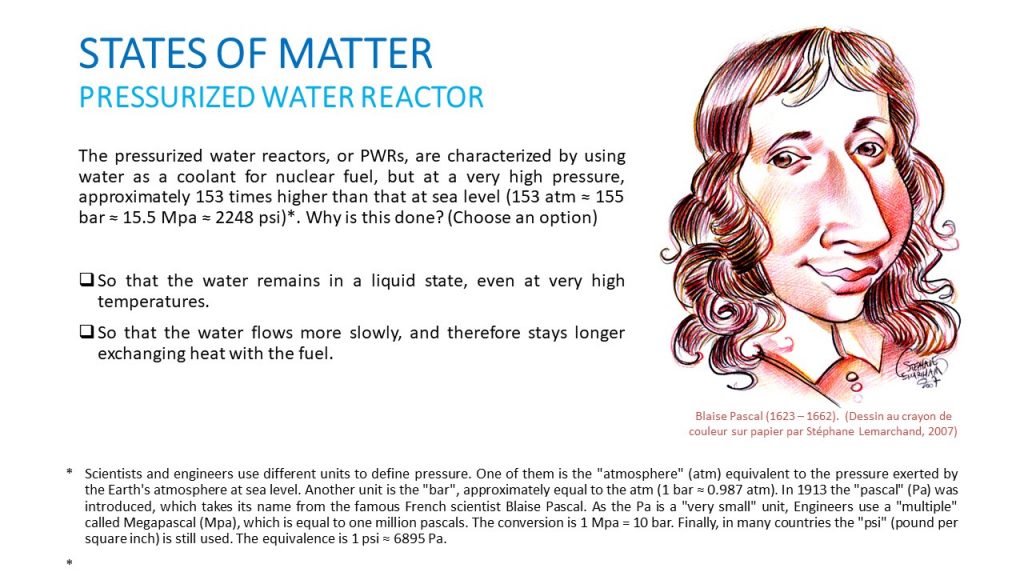
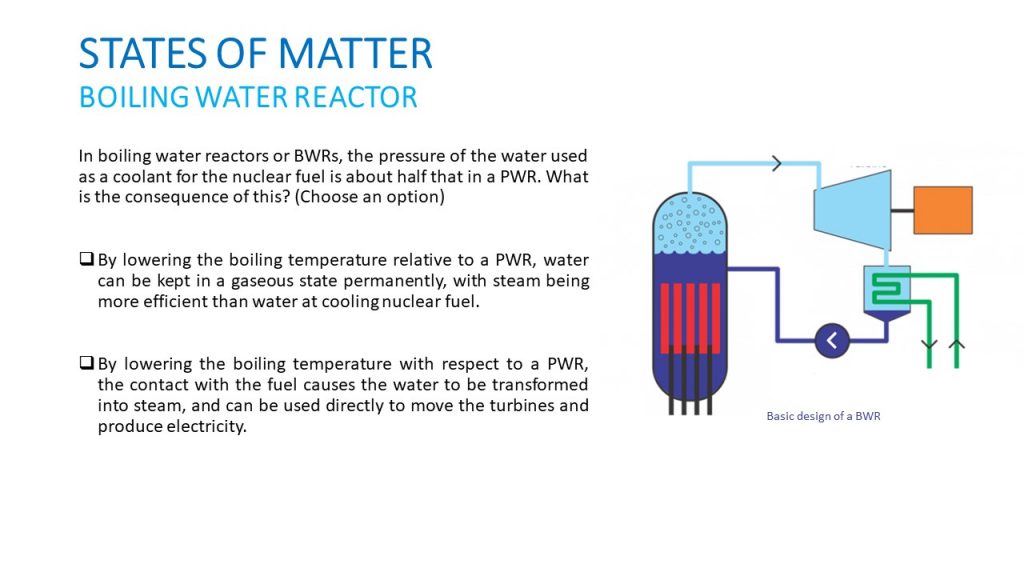
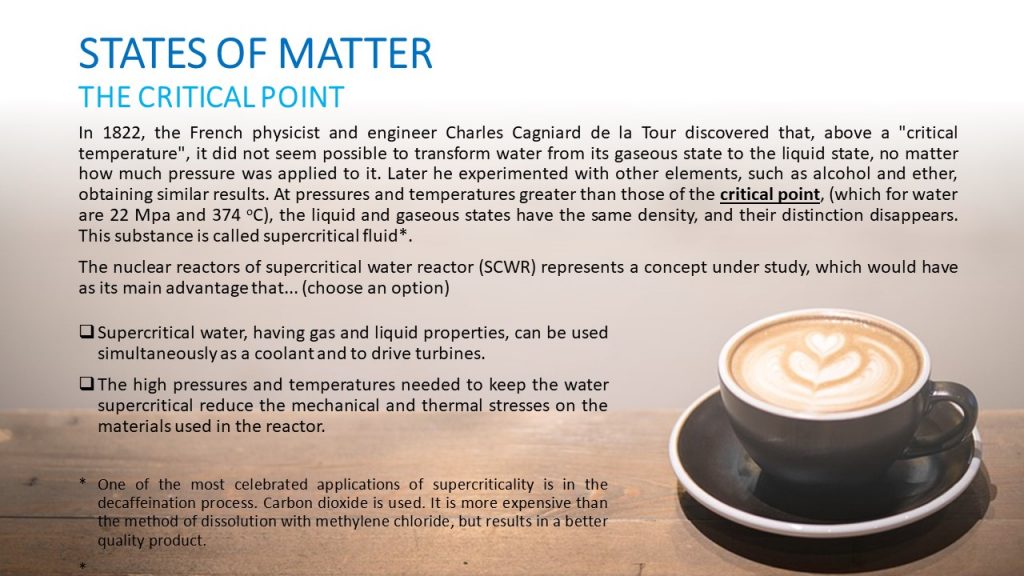
Cuestionarios en español
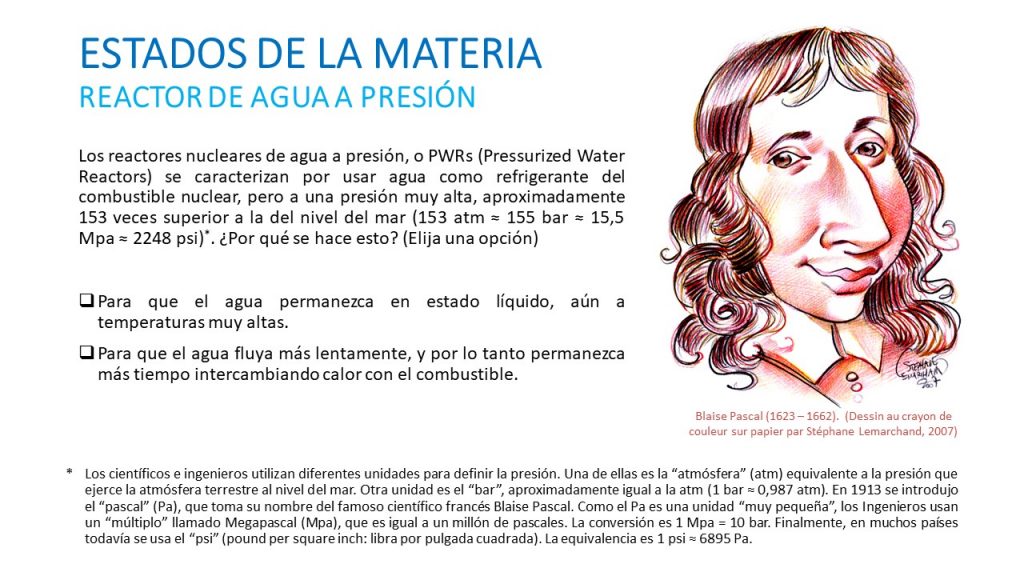
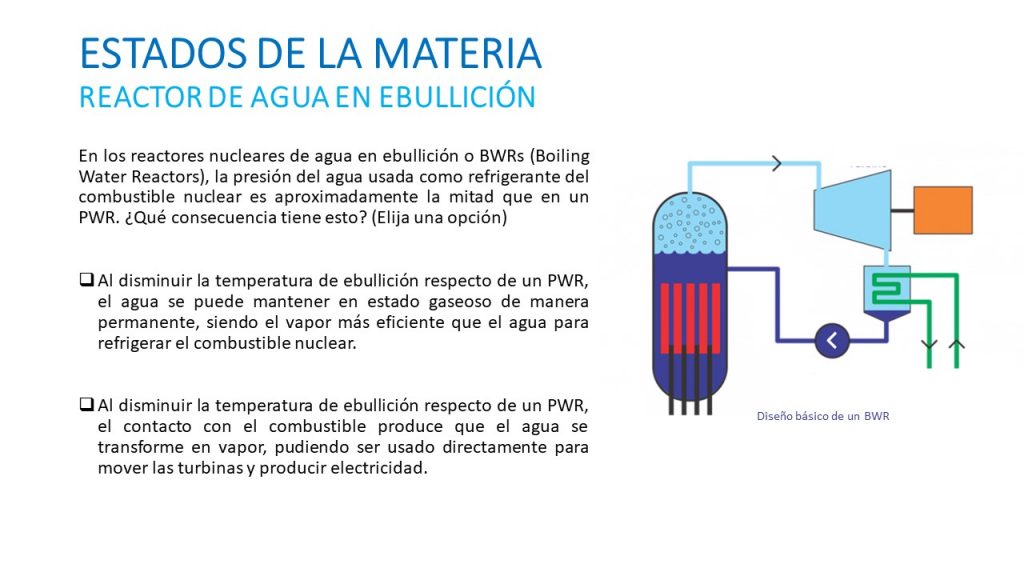
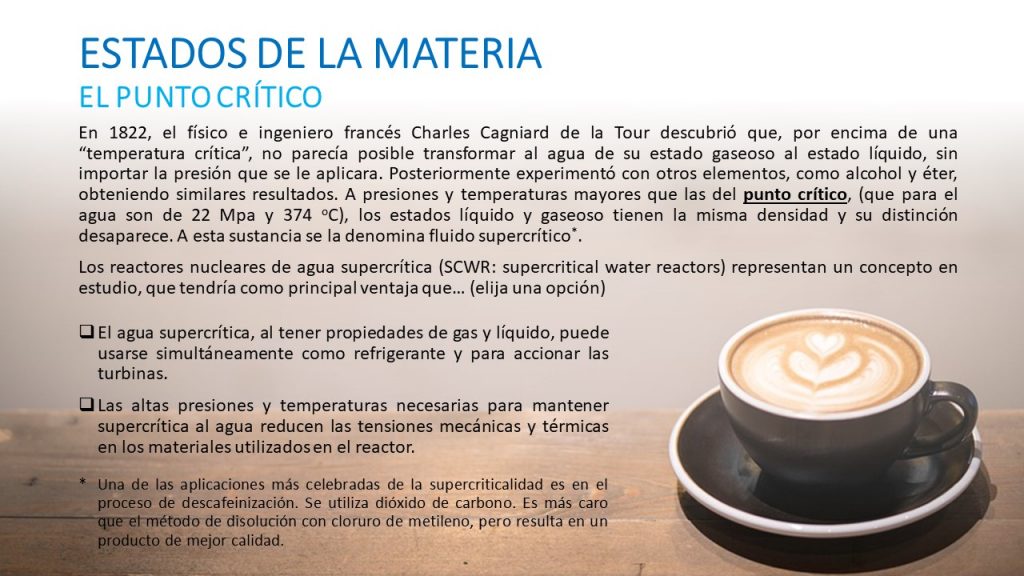
Quiz in italiano
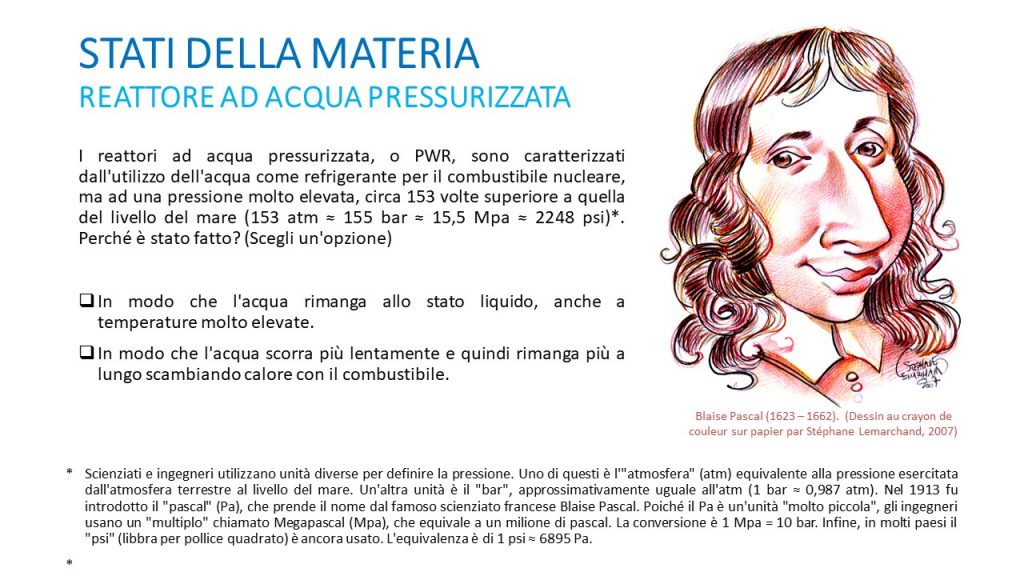
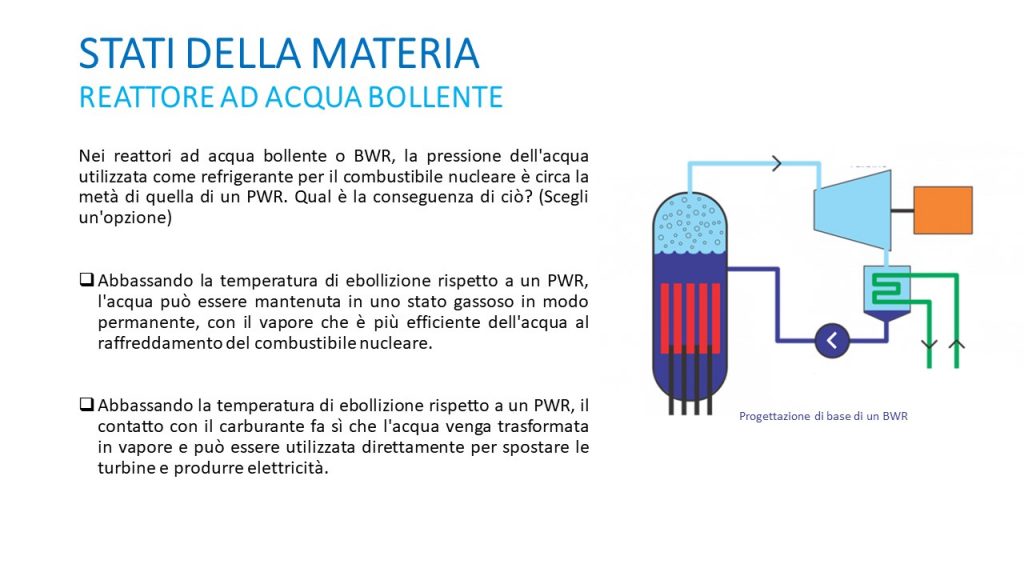
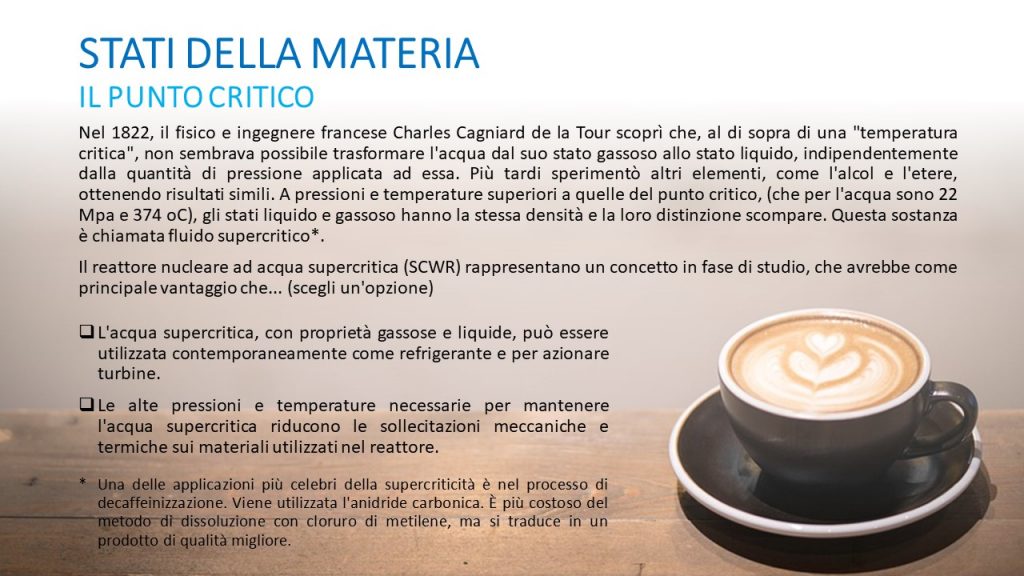
Phase III: Translation
- To evaluate the feasibility of adapting this material to different regional schools and languages, a machine translation of the Spanish version into English and Italian was carried out.
- Each script and the quizzes can be translated automatically in a few seconds, as shown in the following video.
- The soundtrack is easily replaced in the video. In general, the most time-consuming task is rendering, but it is done automatically by the video editor.
- This process can be carried out in any language.
Let’s play LEGO
The proposals elaborated in the previous section can be made as three successive phases, so that once one of them is finished, the next one is started.
Another approach could be to carry out a pre-training course taking as source and model a particular school. In this context, the modules would be the blocks of a scalable, remixable, re-purposable and adaptable set, which could be put together to fit another NEM course, according to its particularities. In profane terms…
The modules would be like pieces of a Lego, taking the ones that are needed to build the pre-training course of each NEM school… and if a brick is missing, it is created on the spot, and added to the set.
The same applies to translation. In principle, all bricks should be of the same color, let’s say a conservative «English» blue. But eventually they could be painted in another color for regional courses. For example, in bright «Spanish» tones for a Latin-American course.
ANNEX:
Program of the Tarragona’s Pre-Training Course
Energy in General
- Introduction
- Units of measurement
- Breakdown according to the Sources
- Electricity – a unique form of energy
- Renewable energy sources (Hydroelectric; Solar Heating; Photovoltaic (PV); Windmills; Biomass; Geothermal and Ocean Energy)
- Nuclear Energy
- Contribution of different energy sources to Greenhouse gas emission
Nuclear Basics
- Radiation Units and Radioactivity
- Impact of Radiation with Matter
- Nuclear Fission
- Applications of Ionizing Radiation apart from Electricity Production
- Nuclear Reactors
How a Nuclear Reactor Works
- Fuel
- Why is a Moderator Needed?
- Why does uranium need to be enriched?
- Criticality – Controlling the chain reaction
- Changes in Fuel Over time – Refueling
- Production of Fissile Material in the Core
- Reactors: Past, Present and Future Possibilities
- Today’s reactor families
- Future Possibilities
Nuclear Fuel Cycle, Radioactive Waste Management and Disposal
- Mining and Milling
- Conversion
- Enrichment
- Fuel Fabrication
- Nuclear Power Plant
- Reprocessing
- MOX Fuel Fabrication
- Electricity
- Spent Fuel Storage
- HLW and Spent Fuel Disposal
- General analysis
Nuclear Safety, Security and Safeguards
- Nuclear Safety Objective
- Key principles of Nuclear Reactor Safety
- Safety principles of specific nuclear reactors (PWRs)
- Safe Construction
- Safe Operation
- Feedback from Experience
- Nuclear Security and Safeguards

